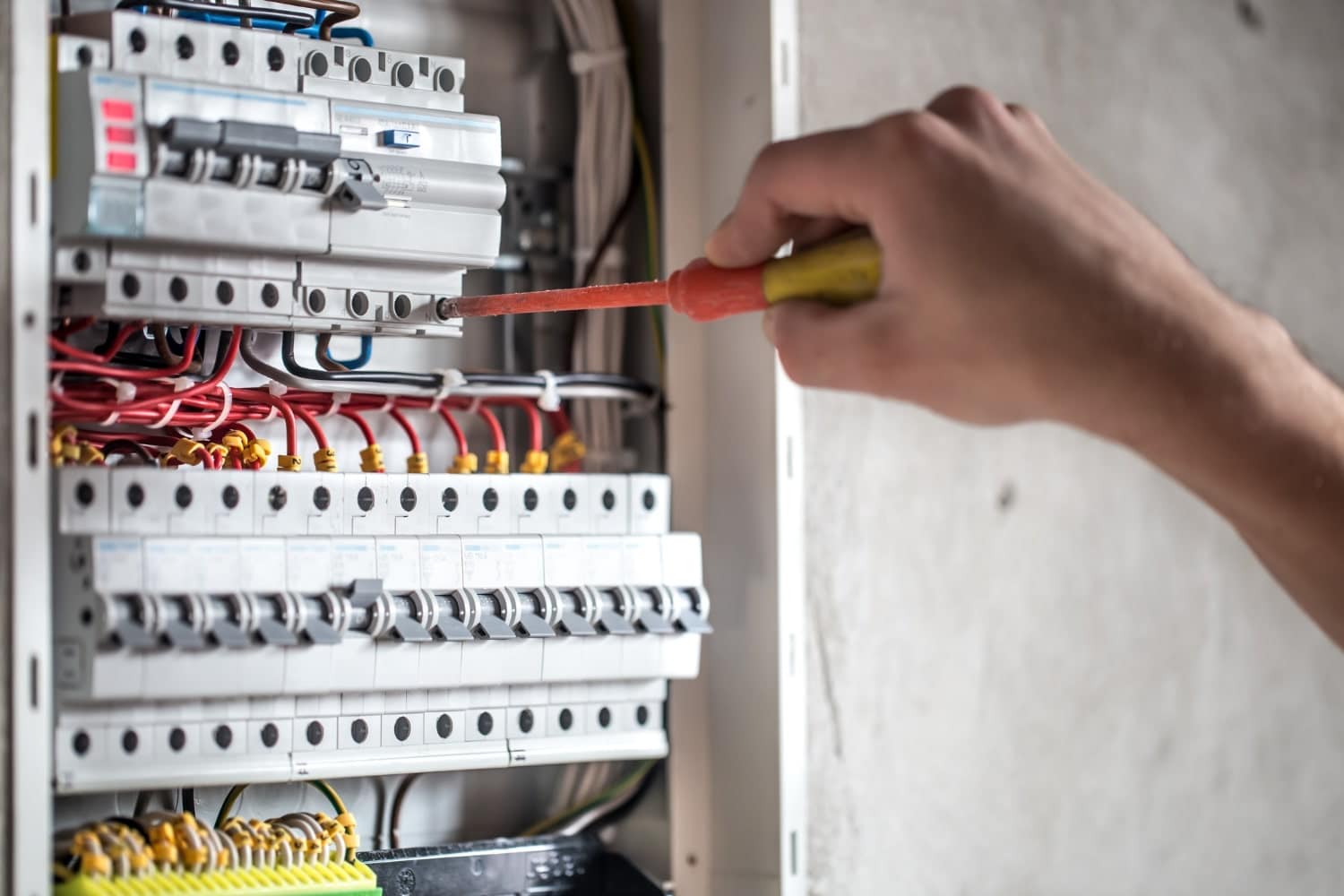Understanding Your Breaker Box Panel
Understanding your breaker box panel is important for keeping your home’s electricity safe and working well. The breaker box, also called an electrical panel, holds circuit breakers. These breakers control where the electricity goes in your home.
Key parts of the breaker box include the main breaker, individual circuit breakers, and labels that show what each breaker controls. Regular maintenance and inspections can help find and fix corrosion and other issues to keep everything working at its best.

What Is a Breaker Box?
A breaker box also called an electrical panel or circuit breaker panel, is the main control center for electricity in a building. It contains circuit breakers. These circuit breakers manage the flow of current and protect electrical circuits from power surges, overloads, or short circuits. Each circuit breaker is linked to a specific area or appliance, ensuring the building’s power is used safely and efficiently.
The main job of the breaker box is to keep the electrical system safe from dangers like electrical fires or damage to equipment. When an overload or fault is found, circuit breakers stop the flow of electricity to reduce risks and improve safety. Regular maintenance and understanding how the breaker box works are important to keep everything running well and avoid electrical problems.
Knowing how the electrical service panel is set up and works is important for property owners and professionals. This includes identifying different types of circuit breakers and knowing how to reset them when needed. Following safety rules when working with or checking the breaker box is very important to avoid electrical accidents.
Importance of Circuit Breakers
Circuit breakers are crucial for protecting electrical circuits from getting too much power or having short circuits. They help keep the whole electrical system safe and working well. These devices act as important guards against possible electrical dangers. Circuit breakers automatically shut off the power if they detect a problem, stopping electrical overloads that could cause fires or damage electrical appliances and buildings.
Each breaker watches the electrical current. If there is too much current or a short circuit, the breaker trips and cuts off the power. This quick action reduces risks and keeps the electrical system safe. Breakers are not just useful; they are essential for keeping homes and businesses safe.
Breaker panels also help organize and control how power is spread out. The way breakers are placed and chosen ensures each part of the system works safely, lowering the chances of problems.
Knowing how important circuit breakers are is key for anyone who takes care of electrical systems.
Components of a Breaker Box
Understanding the parts of a breaker box is key to making sure your electrical system works well and is safe. A breaker box, also called a distribution board or panelboard, has important parts that control and spread electrical power in a building. These parts include the panel cover, circuit breakers, and the main breaker. Each part is crucial for keeping the system working properly and safely.
- Panel Cover: This is the main shield that keeps people from touching live electrical parts.
- Circuit Breakers: These are safety devices that stop electricity flow if there’s an overload or short circuit, which can prevent fires.
- Main Breaker: This part manages the total amount of electricity and ensures the system doesn’t get overloaded.
Knowing what each part does helps you handle issues like tripped breakers and keeps your electrical system running safely.
Understanding Breaker Box Labels
Labeling your breaker box is very important for fixing and taking care of your electrical system. If you label it well, you can quickly find and fix electrical problems without guessing. Each circuit breaker should have clear labels showing what it controls.
Reading the labels on your breaker box should be easy. The labels should be easy to read, preferably typed, and attached next to each breaker switch. This helps you quickly find which circuits control certain areas or appliances in your home, which is useful for regular maintenance or emergencies.
Having clear and consistent labels on your breaker box helps you understand how electricity is spread across the panel. This prevents accidental power cuts to important areas.
When you make or update these labels, write down what each circuit does, like ‘Kitchen Lights’ or ‘HVAC System,’ and match this with the main layout of your breaker box.
Reading the Breaker Panel
Reading a breaker panel means figuring out what each circuit breaker does. Each breaker protects a specific part of the electrical system by stopping electricity flow if there’s an overload or short circuit. It is important to know which breaker controls which area or appliance.
Breakers have different jobs. Some protect lights, others protect kitchen appliances, and some protect HVAC systems. Knowing this helps you fix electrical problems, especially if a breaker trips.
When a breaker trips, it moves to a middle position, not fully on or off, to stop electricity and prevent damage or fire. To reset a tripped breaker, first, fix the problem that caused it to trip. Then, turn the breaker off before switching it back on.
Understanding your breaker panel helps keep your electrical system safe and makes troubleshooting easier.
Different Types of Breakers
Circuit breaker panels use different types of breakers to handle various electrical loads. Single-pole breakers are the most common. They are usually rated for 120 volts and 15-20 amps. These breakers protect individual circuits like lights and outlets.
Double-pole breakers are rated for 240 volts and come in 20-60 amp sizes. They are used for bigger appliances like dryers and ovens.
There are also dual-function breakers. These combine ground fault circuit interrupters (GFCI) and arc fault circuit interrupters (AFCI). They protect against ground faults and arc faults, helping prevent electrical fires and shocks.
In homes, 20-amp breakers are common. They make sure circuits do not go over their safe load limit.
Knowing these differences is important. If a circuit breaker trips, it means there is an overload or fault in the circuit. Using the right breakers in the panel box helps keep the property safe and ensures efficient electrical use.
What to Do if the Switches Aren’t Labeled
If you find an electrical panel with no labels, start by identifying and labeling each breaker.
First, turn off all the breaker switches. Then, turn on one breaker switch at a time to see which area or appliance gets power. You can ask a helper to watch the lights or appliances while you do this.
Label each breaker switch with its function. This will help you quickly find the right breaker when needed. Use a temporary marker until you are sure of each circuit.
If a breaker trips and turns off, use the reset button to turn it back on. Make sure the breaker switches work properly and the panel is in good condition. Labeling the panel correctly makes it safer and easier to use.
Write down this process so you can do it easily in the future. This way, you will understand your electrical system better and keep things organized and safe.
Common Breaker Issues
Homeowners often face problems with their circuit breakers, which can disrupt power and create safety risks. A common issue is overloaded circuits. This happens when too many electronic devices use power from the same circuit, causing the breaker to trip. This stops the power to prevent overheating and possible fires.
Another problem is breakers that won’t reset. This could mean there is a short circuit or ground fault, which needs a professional to check it out. Older breaker panels might have worn-out parts that don’t work right, making them dangerous.
To fix these issues, you should follow safety steps. Regular checks, managing how much power you use, and replacing old breakers on time are important. Also, getting a certified electrician to look at your system helps find and fix dangers.
Resetting Tripped Breakers
Resetting a tripped breaker involves finding the breaker that is in the ‘middle’ position, switching it to ‘off,’ and then turning it back to ‘on.’ This process helps restore power and ensures your electrical system works properly.
To reset a tripped breaker correctly, know its amperage rating and how much load it can handle. If a breaker trips often, there might be a bigger problem that needs fixing or you might need to upgrade your electrical panel.
Always follow safety rules and call a professional electrician if the problem keeps happening.
Safety Precautions
Safety is very important when handling circuit breaker panels to avoid electrical shocks and stay safe. Follow strict safety rules whether you’re a professional or a homeowner doing DIY work.
One key rule is never to touch circuit breakers with wet hands because water can cause electric shocks. Also, make sure the panel cover is always on to avoid touching live wires by accident.
Before you check or fix anything, get a professional to look for hidden fire risks. They can find problems that you might miss, helping to keep things safe.
When working with your breaker box, always put safety first. Don’t take off the panel cover unless necessary, as exposed wires can be very dangerous.
Remember, circuit breaker panels are not always a DIY job. If you’re unsure, call a qualified electrician to do the work properly and safely. This way, you can avoid accidents and make sure everything meets electrical codes.
Preventing Overloads
To keep your home’s electricity safe and working well, knowing how to prevent circuit overloads is important. Circuit breakers protect your home’s electrical system by shutting off the power supply when the current is too strong. By managing the amount of electricity (amperage) and spreading out the load, you can stop breakers from tripping and causing problems.
- Find out the amperage rating of each circuit breaker.
- Calculate how much electricity each circuit is using.
- Don’t use too many high-energy appliances simultaneously on one circuit.
- Check circuit breakers often for any signs of damage.
- Call a professional electrician for help with complicated electrical loads.
Signs You Should Upgrade or Repair Your Electrical Panel
If your electrical panel keeps tripping, makes strange noises, or shows signs of wear like rust or corrosion, it might be time to upgrade or repair it. These problems can mean your home’s electrical system isn’t safe or working well.
Frequent tripping often means your panel can’t handle the electrical load, so you might need a bigger panel. Strange noises like buzzing or crackling usually mean there are loose connections or bad breakers, which can be a fire risk. Rust or corrosion shows that parts of the electrical panel box are worn out and need fixing or replacing.
It is important to follow local codes when fixing or upgrading your panel to make sure everything is safe and legal. You should hire a licensed electrician to check your panel and do any necessary work. They have the skills to ensure everything meets safety standards, protecting your home and everyone in it.
Can I Perform Maintenance on My Electrical Panel Myself?
Working on your electrical panel can be dangerous and complicated. You need to know a lot about electrical safety and local rules. Maintenance involves checking circuit breakers, tightening connections, and looking for wear or corrosion.
First, turn off the main power to avoid electrical shocks. Use insulated tools and make sure your hands are dry. Don’t remove the panel cover unless you understand the risks and have taken safety steps.
You can do simple tasks like cleaning the area and looking for overheating. But, finding fire hazards or fixing broken parts usually needs a professional. Mistakes with circuit breakers and wiring can cause fires and injuries.
While you can do some basic maintenance, the risks make it important to get a professional to check your electrical panel for safety and compliance with local codes.
Hiring an Electrician
Regular breaker testing is very important to keep your electrical system safe and working well. This helps find problems early before they become big issues. Testing makes sure the breaker box and breaker panel do their job right. It checks that breakers trip as they should during overloads and that their amperage rating is correct.
- Look at Breakers: Check them often for wear, rust, or damage. This keeps things safe and avoids sudden failures.
- Test Breakers: Turn breakers off and on to see if they work right. If they don’t reset or trip too easily, you might need new ones.
Check Amperage Rating: Make sure each breaker matches its set amperage capacity. This helps prevent overloads and fire risks.
Compliance With Local Codes
Ensuring compliance with local electrical codes is crucial for the safety and legality of any work involving circuit breaker panels. Following these rules helps your electrical system run safely and reliably.
- Permits: Get the necessary permits before starting work.
- Licensed Electrician: Hire a licensed electrician to ensure compliance.
- Upgrading the Panel: Make sure upgrades meet local code standards.
- Periodic Testing: Regularly test the system to maintain compliance.
Compliance with local codes starts with getting the right permits. These permits show that your planned work meets safety standards. Hiring a licensed electrician is important because they know the complex code requirements and can ensure all installations and upgrades are up to standard.
When upgrading the panel, follow local code rules to avoid any legal or safety problems. Regular testing of breakers and components helps maintain compliance and find any electrical issues early. Keeping the panel area clean and free of clutter also improves safety and compliance.
Updating panel labels is important for clarity and accuracy, making maintenance and emergency responses easier. Following these practices not only keeps everyone safe but also meets legal requirements, protecting both property and lives.
Checking for Corrosion
Maintaining compliance with local codes means regularly checking the circuit breaker panel for corrosion. Corrosion can damage the system and make it unsafe. It can cause electrical problems like short circuits and fire risks. Regular maintenance helps ensure your electrical services system lasts a long time and works well.
When checking for corrosion, look for signs like discoloration, flaking metal, or white or green residue around the breakers and terminals. Regular testing and visual checks help find these problems early.
- Inspect all breaker terminals and connections: Look for rust or residue that shows corrosion.
- Schedule professional inspections: Have a licensed electrician do thorough inspections to find and fix any hidden problems.
Amperage Ratings
Knowing the amperage ratings of circuit breakers is crucial for keeping your electrical system safe. Each breaker panel is designed with specific breaker ratings that show how much electrical flow it can handle. These ratings help prevent overloaded circuits, reducing the risk of electrical fires.
You can find amperage ratings marked on the breaker switches. These ratings must match the wiring and appliances they protect. For example, household breakers are often rated at 15, 20, or 30 amps. Using the wrong breaker can cause safety devices to fail, which are supposed to trip and stop electrical flow during an overload.
When choosing or checking circuit breakers, always look at the panel’s documentation to ensure they are compatible and safe. Using the wrong amperage rating can weaken the whole electrical system.
Understanding these ratings and making sure they fit your electrical needs is key to maintaining a safe and working electrical setup.
Fuse Box vs. Circuit Breaker Panel
A fuse box and a circuit breaker panel both help keep a building’s electrical system safe, but they work in different ways.
- Fuses: In a fuse box, fuses stop the flow of electricity when too much current passes through. The fuse melts to break the circuit. Once a fuse blows, you must replace it.
- Circuit Breakers: A circuit breaker panel uses switches that trip when there is an overload or short circuit. You can reset these switches after fixing the issue.
Key Differences:
- Replacement: Fuses need to be replaced after they blow. Circuit breakers just need a reset.
- Maintenance: Fuse boxes need more upkeep and part replacements. Circuit breaker panels are easier to maintain.
- Safety: Circuit breaker panels have better safety features, like ground fault and arc fault protection, which fuse boxes don’t have.
If you have an older building with a fuse box, it is usually a good idea to upgrade to a circuit breaker panel for better safety and reliability. Knowing how these systems work can help prevent electrical problems and keep everyone safe.

